Lothar Götz is a German artist who lives and works in London and Berlin and is an Associate Professor of Fine Art at the University of Sunderland. He is interested in space, colour, form and how colours impact our perception of space. His practice spans drawing and painting through to full size wall paintings and site-specific installations for settings that have included museums, underground stations and hospitals. He has had solo exhibitions at Chisenhale, London, The Collection Lincoln, Kunsthalle Wilhelmshaven and Kunstverein/ Künstlerhaus Hanover.
Court Spencer caught up with him to find out more about his practice and what he’s working on at the moment.
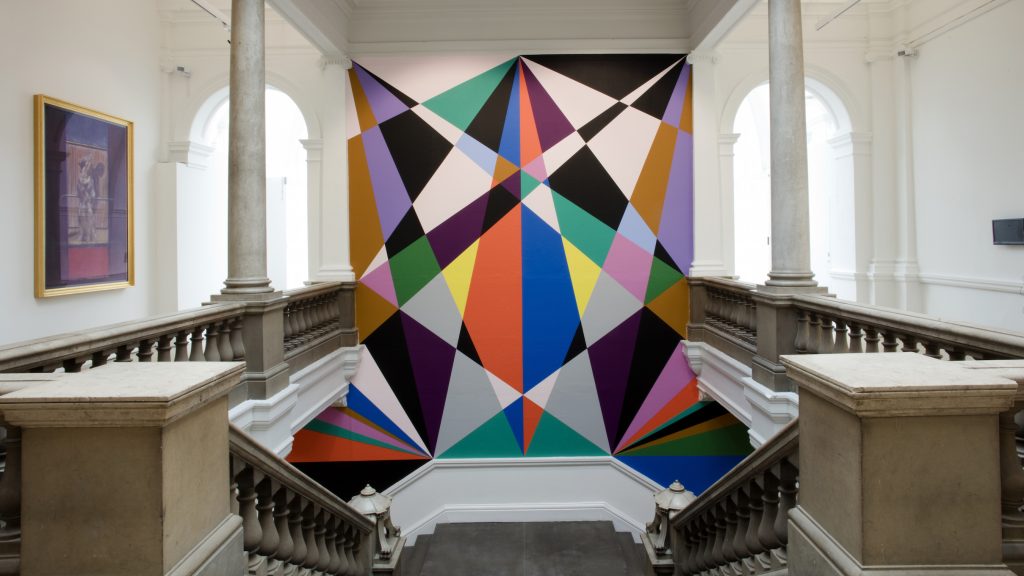
Part of Xanadu at Leeds Art Gallery, Leeds (Photo credit: Jerry Hardman Jones)
Court: Hello! It’s so nice to meet you. And thank you for your time today. As you know, I was really excited at the Trinity Buoy Wharfe Drawing Prize to see your working drawing made for Xanadu, the wall painting in the central staircase at Leeds Art Gallery. I love the contrast between the drawing and painting in terms of scale but also that the drawing as a working drawing, whilst the painting is resolved, refined and very much the final piece. Can you start by telling us a little about how you approach these site-specific wall paintings/installations?
Lothar: The site-specific wall paintings develop in conversation with the space they are designed for and interact with. Like with the staircase in Leeds Art Gallery I usually start with a site visit to investigate the space and surroundings. This is when I start a dialogue with the space and architecture. During this process I do many sketches collecting ideas about possible shapes and colours. Each of my wall paintings is specifically designed for the respective space and I never repeat the same painting. Dimensions and shapes are in direct relationship to the dimensions and character of the space. Given light conditions, materials and colours are important.
After the initial site visit, I go back to my studio and start working on different options.
Court: So drawing really underpins all aspects of your practice. It feels like there are perhaps two types of drawings for you. Working drawings that are used to figure out a space and how to respond to and these are used to paint from. And then there are drawings that are made as final artworks. Is that a fair assessment? And how do the two differ for you?
Lothar: Yes, that’s correct, there are sketches which act as working drawings for future projects in preparation of bigger art works and then there are drawings which are finished works in their own rights. The preparatory sketches are open to change, the other drawings are more refined and are usually drawn in a more precise way.
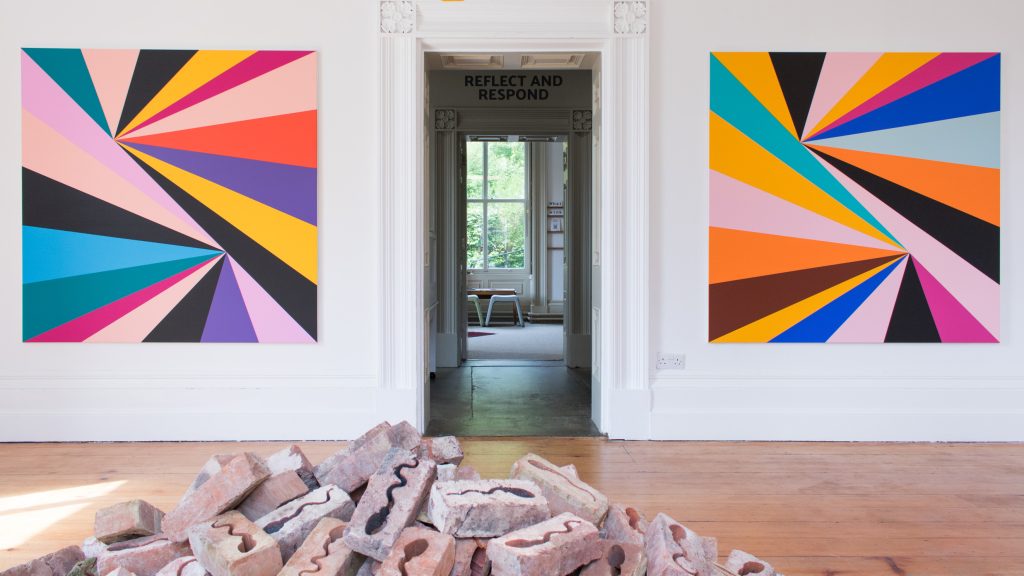
Install photo from WINK WINK with work from the Disco Series. (Photo credit: The Whitaker)
Court: You were recently in WINK WINK, a group show curated by Garth Gratrix at the Whitaker Museum. You were showing two paintings from your Disco Series. Do you make preliminary drawings for paintings such as these?
Lothar: Some of my paintings are based on drawings but not all. I do like to start paintings from scratch as this can be an exciting process. With the Disco Series, all these paintings I started directly on the canvas and there are no preparatory drawings.
Court: I know you’ve said that your drawings often emerge in quite an intuitive way. Do you have an idea, shapes, mood or colour palette that you consciously take into a drawing?
Lothar: The drawings, which are independent artworks, often start with a response to an existing artwork, architectural plan, historical artwork or specific place from memory. They can be quite formal and begin with a simple play with the dimensions of the paper. I might just draw a dividing line, structure the page into sections or connect the corners of the paper. The following shapes develop as reactions to these simple initial drawn shapes. The story of the drawing starts from there, it can be quite intuitive and usually I do not know what the final result will look like. Most drawings come as a surprise to me. Shapes develop in response to each other and so do the different colours. The layout of the drawings is not really planned in advance.
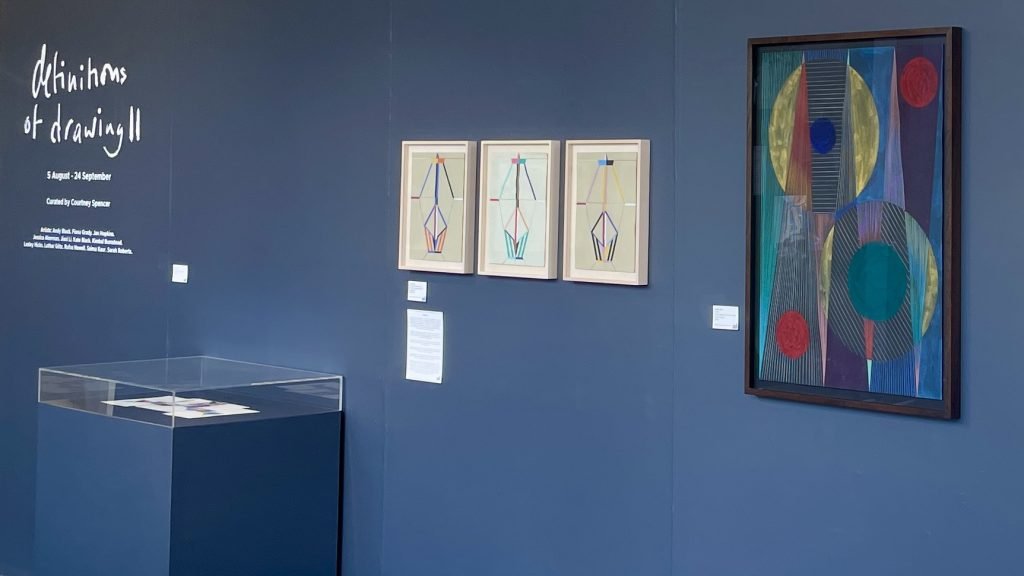
Install view from Definitions of Drawing II with working drawing for Xanadu, House for the Workers and Untitled.
Court: I suppose that’s the exciting part, to see what you create and what unfolds as you respond to shapes and compositions. For Definitions of Drawing II, I was so pleased you agreed to show a working drawing from Xanadu alongside some of your other works. We showed three pieces from the series House for the Workers. Can you please tell us a bit about these and if they’re about or responding to something specific? And how do you go about titling work?
Lothar: The drawings from the series House for the Workers are all based on a design for working clothes by Aleksandr Rodchenko. Similar like with developing my site-specific wall works, I do respond to something given and it is very much about my relationship to and interaction with the historical artwork. It is a kind of visual academic research process. Titles describe or reference sometimes this process or sometimes they relate more to my own vision and phantasy. If I cannot find an appropriate title I am happy with I leave the pieces untitled.
Court: After studying in Germany, you moved to the UK to do an MA at the Royal College of Art. You now split your time between the UK and Germany, and you’re represented by a gallery in each. How do you feel the two art scenes differ?
Lothar: Despite the idea of the ‘Contemporary Art World’ as quite a global playing field I do think that there are great local differences. From my own experience these differences manifest themselves mainly in the different references artworks evoke. Depending on the own cultural background a simple abstract drawing can be seen in quite contrasting contexts and the response to the visual stories varies. Often I was quite surprised or amused by these differences as they are not really obvious but more subtle or hidden.
Court: I hadn’t considered that but yeah, there must be huge variation as to how things are perceived based on the cultural reference points of the viewers. How did you initially get into art? Did you come from a creative family?
Lothar: My family was creative, but I am the first full-time artist in the family. I did grow up with an open eye for the arts. I loved to draw and paint from an early age but was as well very close to other art forms like music, drama, architecture, or dance. Whereas my parents would have hoped for me to choose a ‘safe’ profession they were very supportive after I made my choice clear to them.
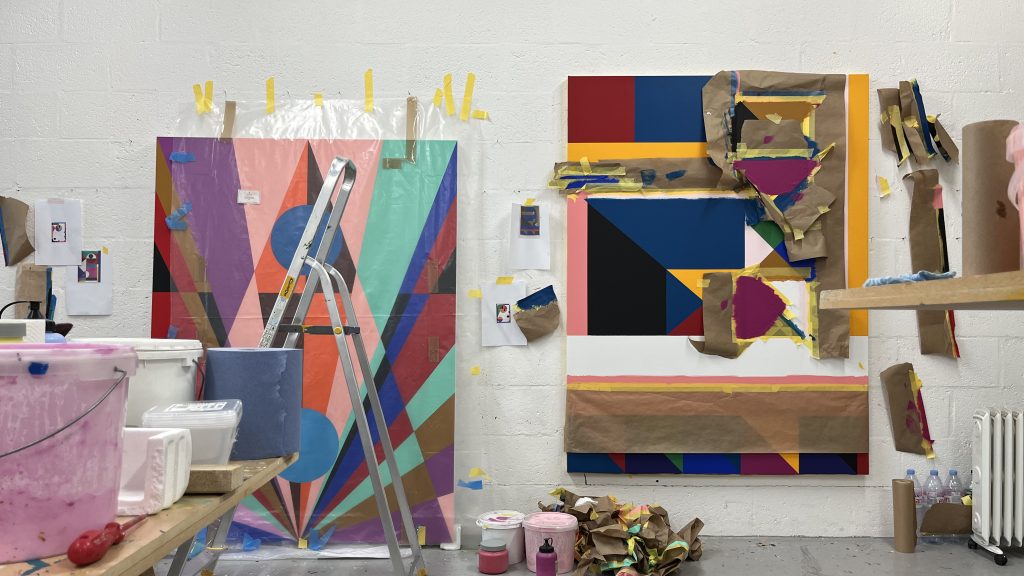
View of the studio. (Photo credit: Lothar Götz)
Court: When did you move into lecturing? And do you feel that this has impacted your practice in any way?
Lothar: I started teaching at Sunderland University around one year after graduating from the painting course at the RCA. I always had a part-time contract which in my eyes is ideal to develop your teaching experience as well as your own artistic practice. Both sides can grow in mutual exchange. There is nothing greater than a good tutorial during which tutor and tutee inspire each other and learn from each other.
Court: That’s great that it can fuel your own practice. Is there any advice you would give students or early career artists?
Lothar: Don’t compromise too easily and forget the idea of art as a career only, it is your life.
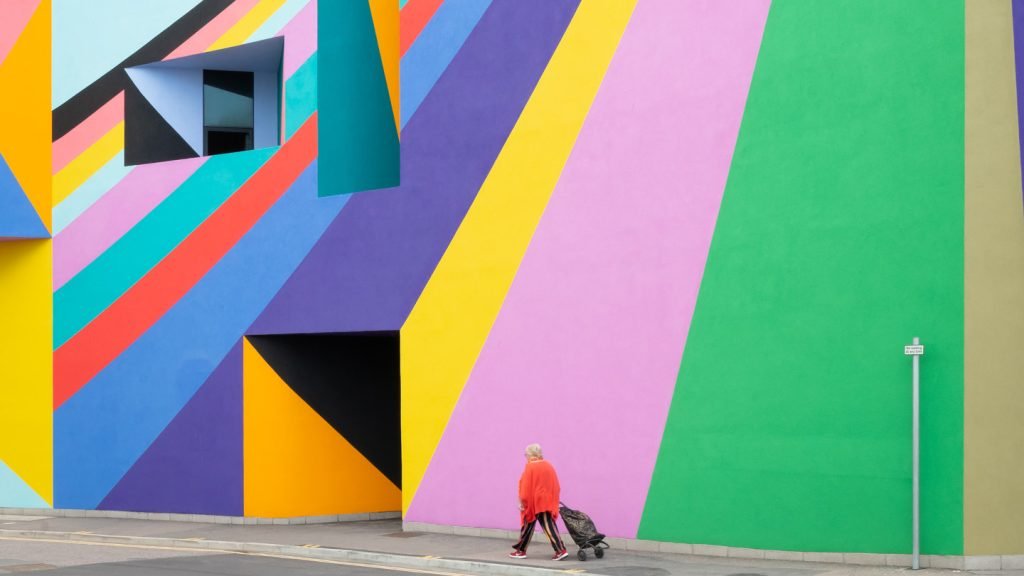
Dance Diagonal at Towner Gallery. (Photo credit: Jim Stephenson)
Court: Yeah, I know what you mean. You rarely hear of an artist retiring from their art. It really is so much more than a career! You’ve made some incredible work and had amazing shows. What are some of your career highlights to date?
Lothar: One of the most recent highlights is probably Dance Diagonal at Towner Gallery in Eastbourne and one of my first highlight was probably my solo show Forever Young at Chisenhale Gallery, London.
Court: Do you have a dream project or something you would love to make happen?
Lothar: As I love curved walls, painting the Guggenheim in New York would be pretty spectacular.
Court: That would be incredible! What are you working on at the moment and what do you have coming up?
Lothar: At the moment I am preparing my next solo show, The Four Seasons at Domobaal in London which is open 30 Sept to 25 November. In addition to that, we are working on a publication with Towner Art Gallery which will be launched sometime towards the end of this year. And there will be a solo show at Mucciacia Gallery, London opening in spring next year.
Court: You’ve got loads on the go! What’s the best way for people to see what you’re up to?
Lothar: On Instagram!
Court: It’s always nice to see some of the work in progress that you post on Instagram. Well thank you so much for your time. As you know, I’m a big fan of your work and this has been an absolute pleasure, so thank you.
Filed under: Art & Photography
Tagged with: abstract, abstract drawing, abstract painting, artist, artwork, drawing, germany, leeds, painter, painting, site-specific, trinity buoy wharf drawing prize, vibrant
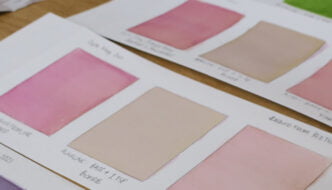


Comments